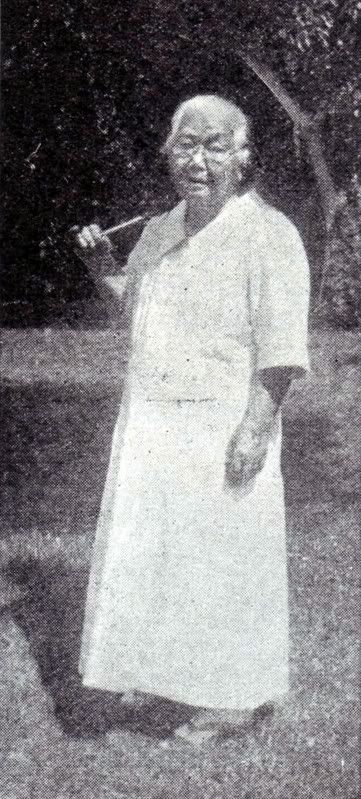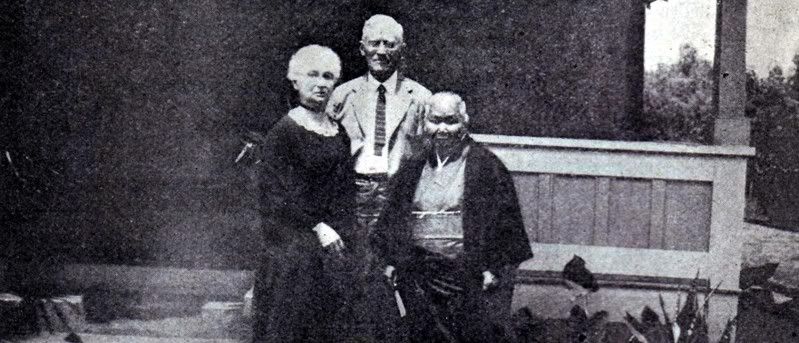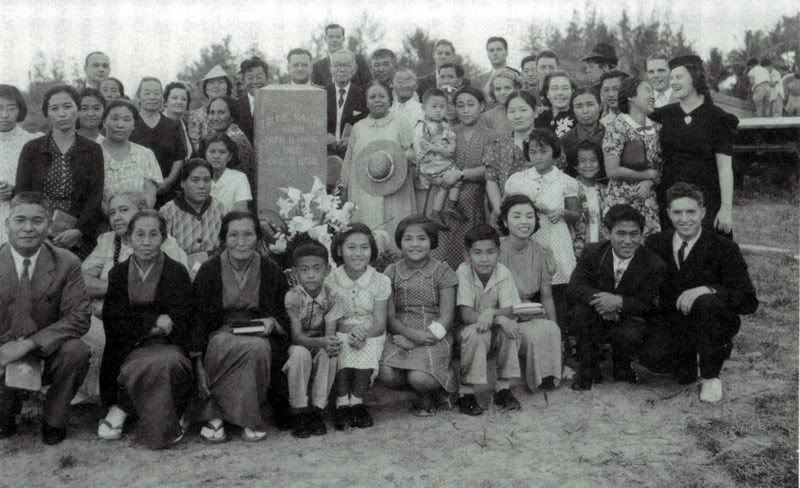It isn’t clear why Tsune Nachie accepted employment in the LDS mission home in Tokyo. The 49-year-old widow, a convert to the Church of England for some 20 years, had long experience working for Europeans and commanded a larger salary than the Mormons could offer her. Yet in the summer of 1905, she became the cook and housekeeper for the elders who had been laboring in Japan since Heber J. Grant had opened the mission in 1901. After four years, they had baptized only seven converts, few of whom remained long with the church. But they had established a successful Sunday School for children in the neighborhood, and one of them – Elder Alma O. Taylor – was slowly translating the Book of Mormon, and they hoped the work would pick up its pace.
Tsune Nachie was born at Komasawa, near Tokyo, on the 6th of April, 1856, one of eight children of Tokuzo Ando and Cho Ishida. She never had the opportunity to go to school, but learned the rudiments of reading and writing from a Buddhist priest. At age 23 she married Sataro Nachie, who died in 1888. Tsune had no children, although she was raising her niece Ei Asano when she came to the mission home; the elders assumed Ei was her daughter, and she never told them otherwise.
Tsune began her employment at the mission home in mid-July, 1905. Only a month later, Elder Taylor recorded in his diary: “Elder Caine had a conversation with our cook, Mrs. Nachie, who said she is convinced that the Latter-day Saints have the truth as taught anciently and that although she has been a member of the Church of England for many years, yet she has heard during her short sojourn with us so many things that ha[ve] given her new light.” Unwilling to rush toward baptism with the poor record of converts during the previous few years, the elders wanted “to test her sincerity a little more and teach her further about the Church & its laws.”
She was an earnest investigator. Day after day, the elder recorded, “I talked with Mrs. Nachie about the 1st Article of our Faith until ten o’clock and then we sang a hymn together”; “I spent the evening instructing Mr[s]. Nachie more fully in the peculiar features of ‘Mormonism’”; “I then talked with Mrs. Nachie and one of her friends about the gospel.”
On September 18, Tsune called on her old preacher and left a message with his wife that “investigation had led her to believe in the teachings of Mormonism,” and she intended to be baptized. Then she went to the elders and told them – didn’t ask, but told them – that she was ready to be baptized. Elder Taylor recorded on September 26:
“At about four o’clock we left headquarters to go to the place of baptism. Elder Woodland came from where he is living to witness the ordinance. Sister Tsuta Degushi was in the party; also a lady friend of Mrs. Nachie. We went on the electric car from Sendagoya station to Shinjuku and then walked to the stream which runs in the rear of the water works near a little resort called Juniso. We were allowed to pass through a private garden to the bank of the stream and were not disturbed or looked at during the service. We sang ‘Lo on the Water’s Brink we Stand.’ I offered a short prayer. Then Elder Fred A. Caine led Mrs. Nachie into the water and baptized her. As soon as they had put on dry clothes we returned to headquarters.”
The following Sunday, October 1, “At our fast meeting which convened from 11:30 a.m. we enjoyed a good spirit. Sister Nachie Tsune was confirmed a member of the church and given the Holy Ghost by the laying on of hands.”

 Elder Taylor’s diaries are our chief source of information for Tsune’s early life in the Church. They show her to be a completely involved member, who participated in meetings, discussed principles of the gospel with the elders, served faithfully as an employee (even chasing a midnight intruder out of the house), and working with the few women converts in a sort of proto-Relief Society. She appears most commonly in the record, though, as a missionary – time after time, she invites women friends to stay with her for days at a time, arranging for them to be taught by the missionaries during their visits. At least one such houseguest joined the Church:
Elder Taylor’s diaries are our chief source of information for Tsune’s early life in the Church. They show her to be a completely involved member, who participated in meetings, discussed principles of the gospel with the elders, served faithfully as an employee (even chasing a midnight intruder out of the house), and working with the few women converts in a sort of proto-Relief Society. She appears most commonly in the record, though, as a missionary – time after time, she invites women friends to stay with her for days at a time, arranging for them to be taught by the missionaries during their visits. At least one such houseguest joined the Church:
“November 1st 1907 … In company with all the elders in Tokyo and Sisters Haku and Nachie and the latter’s little girl Ei and Mrs. Tai went to Tamagawa to witness and direct a baptismal service, by which Mrs. Tai was added to the fold of Christ. This is our only baptism thus far this year. The weather being ideal, the water clear and the spot quiet and secluded all hearts rejoiced in the privilege of being present. Mrs. Fude Tai is Sister Tsune Nachie’s younger sister and has been a believer of the Episcopal church for a long time … her father-in-law with whom she lived after her husband’s death is the [Episcopal] preacher at Kawagoe.”
Only once is there a record of any trouble between Tsune and her new brethren in the gospel:
“After class I had a talk with Sister Nachie about her work, calling her attention to some of her unclean ways. This made her rebel and she wanted to quit but I had a talk with her which perhaps will do her some good.”
The nature of Tsune’s “unclean ways” – or rather, Elder Taylor’s misinterpretation of Japanese culture – is suggested in a closely following entry:
“At 11:00 a.m. we held Sacrament meeting. Sisters Nachie and Haku were present. I talked for their benefit upon the evils of the custom among low class Japanese of going naked or nearly so during the hot weather. I told them that it was their duty to respect their persons by keeping them covered in the presence of others and avoid associating with people who didn’t have enough decency to cover up their ugly nakedness.”
But with that exception, there is every sign that Tsune took motherly care of the elders, who in turn displayed great affection and care for her. Tsune often needed medical care for her eyes, and one year the elders paid for another examination and presented her with a pair of gold-rimmed eyeglasses as a Christmas gift. They also paid to send Tsune’s niece Ei (whom they thought was her daughter) to school.
Tsune worked as the elders’ cook and housekeeper for 18 years. Finally, in 1923 and approaching 70 years of age, the elders decided that she was too elderly to continue such steady labor. They would not abandon her, however; the elders then in the mission home wrote letters to every former Japanese missionary they could locate, explaining that their beloved Tsune Nachie needed to retire. It is a testimony to Tsune and the affection she had created among the missionaries that they responded with contributions large enough for Tsune to emigrate to Hawaii, to live where she could work in the temple. The timing was fortunate: Tsune avoided the earthquake that devastated Tokyo later in 1923, and she was safely settled in the mission home at Laie when the Japanese Mission was closed in 1924, which would have left her without a home and without employment.

Tsune hardly settled into a life of quiet retirement in Hawaii. She was the first Japanese convert to enter the temple, and at an unknown date she returned for a brief visit to Japan to collect the genealogical records of other converts’ families so that she could take care of their ordinance work. Without direction – impelled only by her testimony and her desire to share the gospel, this little woman – less than five feet tall – left her small Hawaiian home on a near daily basis to go proselyting among the Japanese of Hawaii, whom no one else was teaching. Church members tried to persuade her to move to Honolulu where there were members who could take care of her, but she insisted on remaining at Laie where she could go to the temple regularly and attend to her private mission among the Japanese.
 In April 1934, a small group of converts organized the first Japanese branch of the Church in Hawaii, and to Tsune’s great joy, she lived to see the 1937 organization of a fully functioning Japanese Mission in Hawaii. Tsune was credited then as “a powerful influence in bringing about that organization” — one that would soon nurture converts with names like Adney Y. Komatsu and Chieko Okazaki. She died in December 1939, at age 83, after 34 years as a missionary.
In April 1934, a small group of converts organized the first Japanese branch of the Church in Hawaii, and to Tsune’s great joy, she lived to see the 1937 organization of a fully functioning Japanese Mission in Hawaii. Tsune was credited then as “a powerful influence in bringing about that organization” — one that would soon nurture converts with names like Adney Y. Komatsu and Chieko Okazaki. She died in December 1939, at age 83, after 34 years as a missionary.
.
.
.
.
Photos, top to bottom:
Tsune Nachie, ca. 1938
Christmas 1920, Tokyo (with visiting apostle David O. McKay)
Tsune Nachie with Japanese Sunday School, in Hawaii, 1937
Tsune Nachie with Elder and Sister Anthony Ivins, in Hawaii
Tsune Nachie’s grave, [Honolulu?] Hawaii
Continue reading at the original source →



